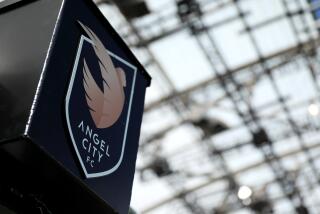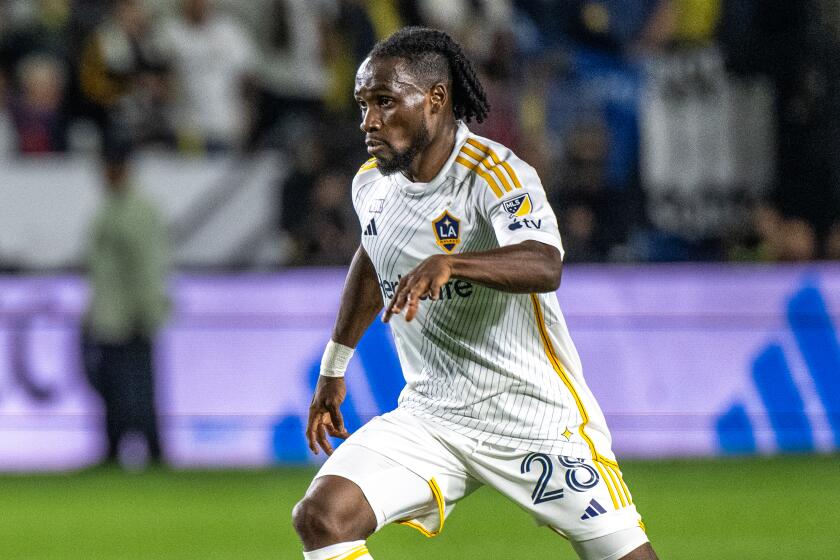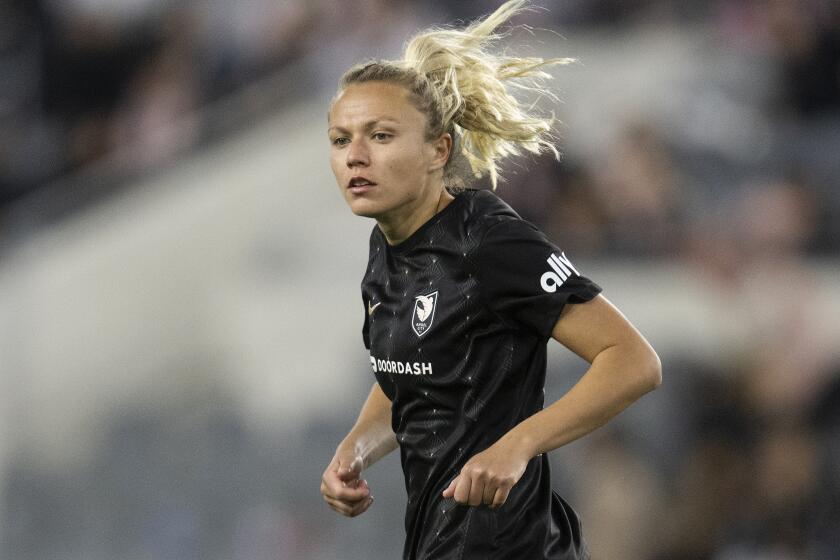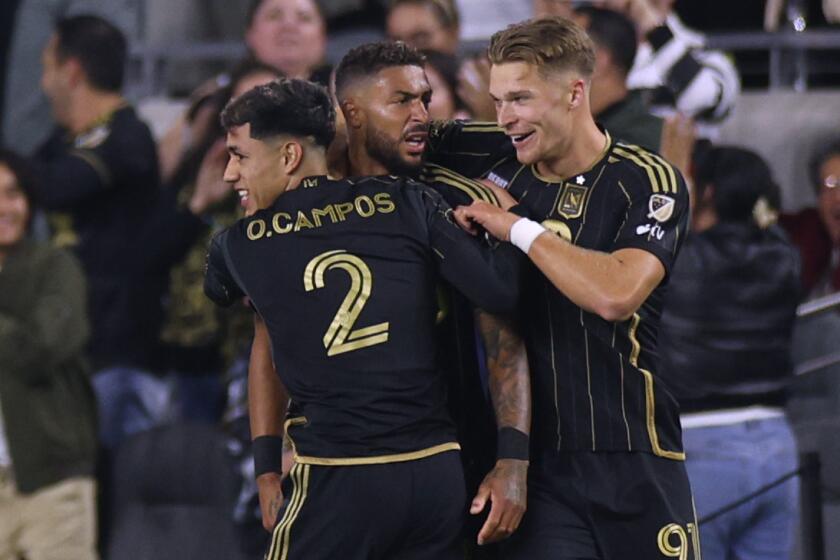It’s easy to flag down American fans at this World Cup
Ryan Appell stood on an isolated stretch of highway on the outskirts of an old South African mining town dressed like Betsy Ross’ worst nightmare.
He worn a bandana and a scarf made from a U.S. flag, had a flag tied around his neck and carried another in his hands. “This,” he said with a smile, “is me.”
And apparently it’s a lot of other Americans too because the U.S. soccer team’s fan base, which once consisted primarily of friends and family members, has swelled into one of the largest contingents at this World Cup.
According to FIFA, the world governing body for soccer, only South Africa bought more tickets to this World Cup than the U.S.
And though some of the 136,500 tickets sold in the U.S. — more than the number sold in Germany, Italy, France, Mexico and Brazil combined — were undoubtedly purchased by fans who came here to root for one of the 31 other teams in the tournament, Appell was hardly the only fan who had traveled halfway around the world to come root for America.
For the Americans’ game last Friday in Johannesburg, fans came wearing an endless array of hats, scarves, pants, shirts and face paint in the design of the U.S. flag. There were also two people dressed as astronauts (carrying a sign reading “South Africa We Have Landed”) and one Elvis impersonator. More of the same is expected Wednesday when the U.S. meets Algeria in its final match in group play in Pretoria.
“You’ve got to represent because all the other countries represent well,” says Shamus O’Shea, a merchant marine from New York who came dressed head to toe in the Stars and Stripes.
American support of soccer appears to be catching up to the rest of the world. Not only has the number of enthusiasts swelled, but the fans are also getting organized, with some 20,000 of them having pledged allegiance to one of two groups that follow the U.S. team around the world — the older, staid Sam’s Army and the appropriately named American Outlaws, a younger, more radical group whose calling card is a stars-and-stripes bandana worn over the face.
“Our goal is to one day have sellout crowds doing chants and songs with us,” says Chris Donahoo, an original Outlaw from Kansas City, Mo. “Going to these games and standing alongside the people who have the passion that I do, that’s patriotism in its purest in my opinion.”
Bravery too.
Donahoo, who has followed the U.S. team to several international matches, attended a match in England in 2008 where the small pocket of U.S. fans was outnumbered more than 500 to 1. “And I was still singing my heart out after losing, 2-0,” he says. “It’s all for love of country and love of the game.”
Robert Waltersdorf, a long-suffering soccer fan from Connecticut, remembers those days. His first World Cup was in France in 1998, where he said he felt alone. “I would stand up and cheer, and it was like silence,” he said.
But as Waltersdorf told his story outside the World Cup stadium in Rustenburg, he struggled to be heard over the army of singing, chanting, horn-blowing U.S. fans that surrounded him. And the game with England, which would end in a 1-1 tie, was still hours away.
“It’s quite noticeable, the increase in the fan support,” says Neil Buethe, senior communications manager for U.S. Soccer. Things started to change just before the 2006 World Cup when his offices were flooded with four times as many ticket requests as they had tickets.
“We weren’t totally prepared for that,” says Buethe, who said U.S. soccer hadn’t gotten that many ticket requests for the 2002, 1998 and 1990 World Cups combined. “Our eyes kind of opened.”
Among the fans who have followed the U.S. to South Africa for this World Cup are Vice President Joe Biden, Miss USA Lisa-Marie Kohrs and TV personality Drew Carey.
“I’ve never seen Americans be so energetic and so patriotic at a game before,” says Kohrs, a broadcast journalism major at Pepperdine who wore stars-and-stripes leggings to her first match in South Africa. “Everyone was wearing flags as capes. And painting their face. I’ve never seen so many people have so much fun at a sporting event in my life.”
Suddenly, it seems, soccer is hip and not just a sport understandable only to those who speak with an accent. Even fans from other countries are beginning to notice the change on the U.S. side.
“You’ve got to be a supporter to come all this way,” says Martin Clarke, an English fan from Newcastle, whose small tailgating group was overwhelmed by U.S. fans before the two countries’ World Cup opener.
American soccer fans have come a long way in the last four years, but they still have some work to do.
“Lots of different countries have their own identity. I don’t know that I’ve actually seen America’s,” says Ann Thompson, an English fan. “It needs to be developed by them and not be orchestrated by someone who thinks this is a good idea, [or] we’ll do this. It evolves. They will find their own way.”
And the U.S. players, who applauded the fans before leaving the pitch after that match, insist the support made a difference.
“Of course it helps,” says striker Jozy Altidore. “And it’s really important for us.
“That’s a huge lift for us when we can go out on the field and see that we have support there.”







